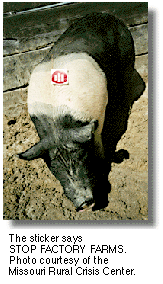|
Dispelling the Hog Factory Myths Who is more efficient?
In 1993/94 the Nebraska Swine Enterprise Records and Analysis Program analyzed the most profitable one-third of the operations. the most profitable operations:
Who provides economic development? Factory farm spin docotrs want us to believe that large scale confinement operations are good economic development. University research does not back this up.
Research done at Virginia Tech compared the impact on the local economy of several independent producers adding 5,000 sows (e.g. 50 producers adding 100 sows each) to corporate farming adding 5,000 sows. The independent producer system provided:
An analysis by the Center for Rural Affairs showed that between 1987 and 1992 North Carolina doubled hog production from 2.5 million to 5.4 million hogs but the number of hog producers dropped 48 percent. In the two counties that have 44% of the hogs:
Who's Fooling Who? The "economic development" and "efficiency" arguments spouted by factory farm advocates is nothing but chuck anf jive rhetoric to:
Joe Fagan is a member of Iowa CCI - Iowa Citizens for Community Improvement. Their address is 1607 East Grand Avenue, Des Moines, Iowa 50318-3504. Phone: (515) 266-5213. |
| Published in In Motion Magazine March 25, 1996. |
If you have any thoughts on this or would like to contribute to an ongoing discussion in the  What is New? || Affirmative Action || Art Changes || Autonomy: Chiapas - California || Community Images || Education Rights || E-mail, Opinions and Discussion || En español || Essays from Ireland || Global Eyes || Healthcare || Human Rights/Civil Rights || Piri Thomas || Photo of the Week || QA: Interviews || Region || Rural America || Search || Donate || To be notified of new articles || Survey || In Motion Magazine's Store || In Motion Magazine Staff || In Unity Book of Photos || Links Around The World NPC Productions Copyright © 1995-2020 NPC Productions as a compilation. All Rights Reserved. |


 The factory farm spin doctors want to tell us that the hog factories are more efficient. But . . .
The factory farm spin doctors want to tell us that the hog factories are more efficient. But . . .